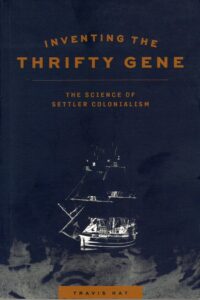Book review: Inventing the Thrifty Gene: The Science of Settler Colonialism
Travis Hay’s Inventing the Thrifty Gene: The Science of Settler Colonialism is a wondrous exploration of the bonds between settler colonialism and settler science. He traces the evolution of colonial science from tropes of Indigenous extinction to the invention of the thrifty gene hypothesis to explain the diabetes epidemic amongst First Nations in the late twentieth century across six chapters. In so doing, Hay ties settler scientific luminaries, like Charles Darwin, to colonial Indian policies advocated by Sir Francis Bond Head in the Victorian era, to the inventor of the thrifty gene James V. Neel in the 1960s and to the 1999 discovery of the gene among the people of Sandy Lake First Nation by medical researchers and scientists from the University of Toronto and Western University.
Hay deftly shows that fore more than a century, settler science remains linked by its study of the other, ideas of Western masculinity, the male white settler gaze, and its “sanitizing of state policies” (4). All of the leading settler scientists were white males, who utilized the expanding settler state to access Indigenous bodies, and used the power of the state – financially, politically, and socially – to engage in the creation of knowledge to benefit settlers.
According to Hay, the knowledge generated by studying the Indigenous – medically and anthropologically – rarely manifests itself to benefit the people being studied. While an exceptional and easy-to-read study of settler colonial science and policy, Hay devotes very little time to the 1999 reinvigoration of the thrifty gene idea and its deleterious impacts on popular imagination and Canadian health policies directed at Indigenous peoples. Regardless, Hay nicely shows that the thrifty gene theory, and its antecedents, were soundly based on the Victorian era myth that Indigenous peoples remain somehow incapable of becoming modern, could not survive the contemporary world, and would potentially vanish at some point in the future.
Finally, the study also shows that these hard held settler myths continue to influence state policies and popular attitudes toward Indigenous people and our health. These settler myths conveniently blame Indigenous peoples for our expected future demise and current poor health – it is our DNA after all. Additionally, these myths also serve to absolve the colonial settler state of its past and contemporary policies that have created and maintained poverty, malnutrition, trauma, violence, and dependency in our communities – all of which created poor health outcomes such as the diabetes epidemic. Simply, throughout Inventing the Thrifty Gene, Hay ably shows that settler science is complicit in masking the real causes of negative Indigenous health outcomes.
Hay’s Inventing the Thrifty Gene is an excellent read. He eloquently explores the history of settler-colonial science, as well as various policies that helped create the mythological notion of the thrifty gene. Hay avoids a jargon-laden dialogue, thus making the book readily accessible to anyone interested in exploring the origins of the thrifty gene and the impacts of settler science on Indigenous peoples within Canada. I do want to note that Hay offers warnings for Indigenous readers prior to particularly difficult sections – such as one that discusses experiments on Indigenous children, or references to experiments on specific communities. These heads-up were greatly appreciated and should appear in more works dealing with difficult histories. He expects settlers to read the book, regardless of the difficulty, to learn and understand some of the history of settler colonial science.
Inventing the Thrifty Gene fits nicely alongside other academic works exploring Canada’s colonially-based medical interventions in Indigenous communities both historically and contemporaneously. Finally, I heartily recommend that anyone interested in colonialism, medicine, anthropology, government policy, and their interconnected histories read this volume.
Travis Hay, Inventing the Thrifty Gene: The Science of Settler Colonialism. Winnipeg: University of Manitoba Press, 2021.
ISBN: 978-0887559402



